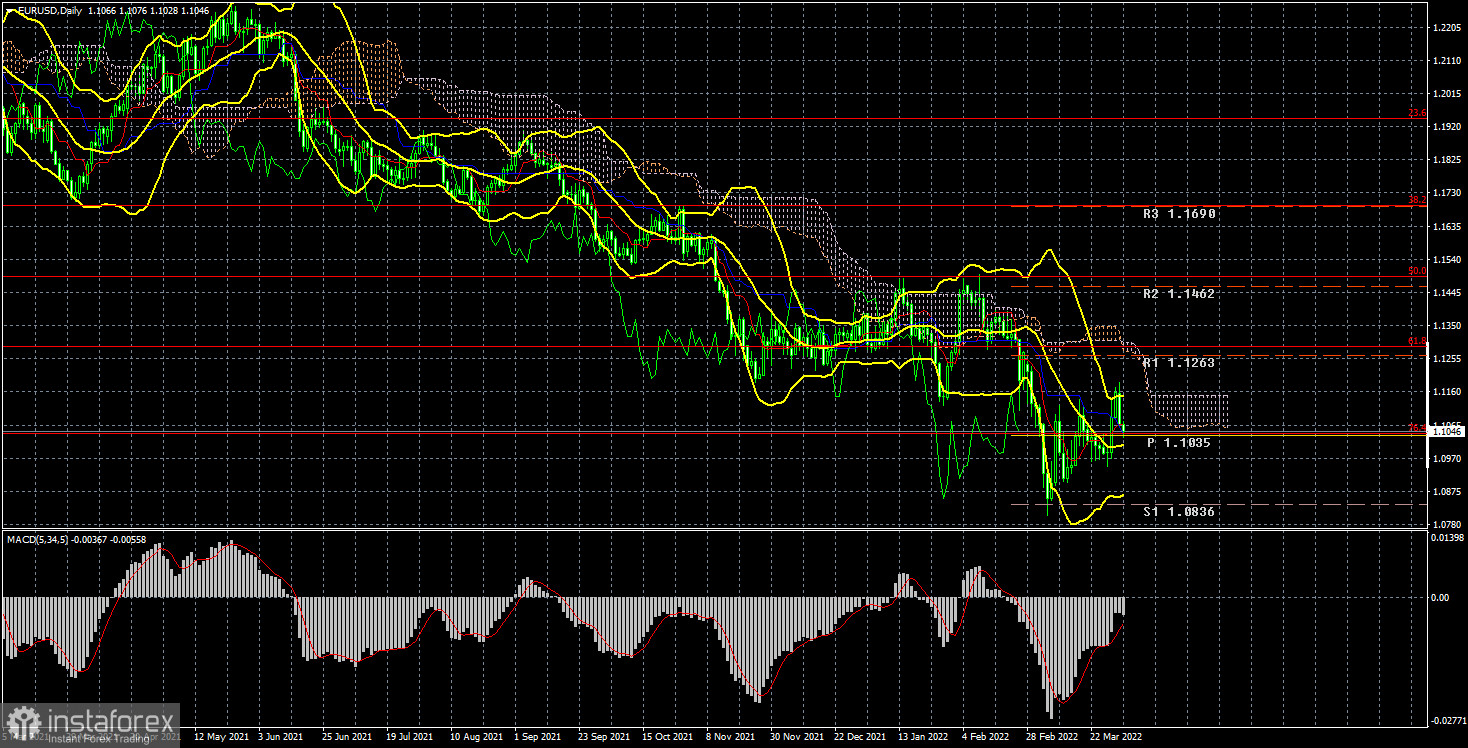Long-term perspective.

The EUR/USD currency pair managed to show pretty good growth during the current week, and at the end of the week - a fairly strong drop. Thus, although the critical line was overcome this week, it is still difficult to say about the impending growth of the European currency. At the moment, the euro/dollar pair is still located below the Ichimoku cloud, so the US dollar still looks more attractive in the eyes of traders. Moreover, the euro has been growing this week solely due to geopolitical factors. That is, absolutely groundless since the geopolitical factor did not give any reason for optimism. On Tuesday, it became known that Kyiv and Moscow can agree on a peace agreement. It is in this interpretation and formulation. The foreign exchange market reacted to this message as if it had already been signed, and Russian troops were already heading back to Russia. All that became known on Tuesday is some progress in the negotiations, which gives hope for an agreement sometime later. However, many political analysts believe that a peace agreement will not be signed in the coming weeks or even months. Many of them say that when the parties want to make peace, they negotiate and cease fire for that time. In the case of the Ukrainian-Russian conflict, nothing of the kind is observed. Therefore, many experts believe that the negotiations are a screen that simply gives Moscow time to adjust logistics, replace army personnel, and relocate certain units. And if so, then there was no reason for the growth of the euro currency this week. It corrected itself, taking advantage of the given chance, but further growth is groundless.
COT analysis.
The latest COT report turned out to be as neutral as possible and did not show any serious changes in the mood of professional traders. During the reporting week, the Non-commercial group closed about 7 thousand contracts for purchase and 4.5 thousand contracts for sale. The net position of this group decreased by 2.5 thousand. At the same time, the total number of buy contracts still exceeds the total number of sell contracts of major players. That is, their mood is still bullish, although the European currency has been falling for 14-15 months. Earlier, we have already drawn attention to the fact that in January and February, major players increased purchases of the euro currency. In theory, this should have led to the growth of the currency itself. However, the euro did not show anything other than the usual slight correction. Since it was in January-February, when the geopolitical situation in the world and Europe began to deteriorate sharply, we assume that at that time the demand for the US dollar was growing very much. That is why there was an increase in the euro/dollar pair, although the demand for euros among market participants was also growing. The demand for the dollar just grew faster and stronger. Now the factor of geopolitics remains in force, therefore, with the "bullish" mood of the major players, it is quite possible to expect a new fall in the European currency. To some extent, this is a paradox, but a paradox explained by the current circumstances that have developed in the world.
Analysis of fundamental events.
During the current week, the most important report was the report on inflation in the European Union. In general, there were a lot of important events and publications during the week, but most of them were again ignored, and market participants paid more attention to geopolitics rather than economics. On Friday it became known that the consumer price index in the EU rose to 7.5% in March. That is, it has almost caught up with American inflation, which is now 7.9%. It is noteworthy, but earlier Christine Lagarde said that she expects inflation to slow down in the Eurozone and refuses to believe in the threat of stagflation. We then assumed that in reality, everything would be exactly the opposite. And so it turns out. GDP in the fourth quarter showed minimal growth, and inflation will soon overtake the American one. Oil and gas prices continue to rise in the medium term and may provoke a new acceleration of inflation. In addition, the European Union is on the verge of a "gas war" with Russia, as well as on the threshold of a "food crisis" due to the military conflict in Ukraine.
Trading plan for the week of April 4 - 8:
1) On the 24-hour timeframe, the pair briefly exceeded the Kijun-sen line, but so far gives no reason to assume further growth. Almost all factors still speak in favor of the growth of the US dollar, and not vice versa. The price is below the Ichimoku cloud, so there is still little chance of euro growth. Rather, the euro's decline will resume with targets of 1.0833 and 1.0661. So far, sales remain the most relevant.
2) As for purchases of the euro/dollar pair, they are not relevant now. First, there is not a single technical signal or sign that an upward trend may begin. Second, the "foundation" and "macroeconomics" continue to exert strong pressure on the euro. Third, "geopolitics" can continue to put pressure on traders and investors who still believe that in any incomprehensible situation it is necessary to buy the dollar. Only overcoming the Senkou Span B line we would consider a strong basis for a new upward trend.
Explanations of the illustrations:
Price levels of support and resistance (resistance /support), Fibonacci levels - target levels when opening purchases or sales. Take Profit levels can be placed near them.
Ichimoku indicators (standard settings), Bollinger Bands (standard settings), MACD (5, 34, 5).
Indicator 1 on the COT charts - the net position size of each category of traders.
Indicator 2 on the COT charts - the net position size for the "Non-commercial" group.





















